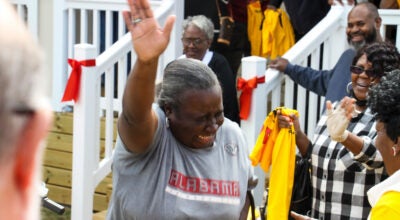Rescue workers help dig out Texans after Hurricane Ike
Published 9:57 am Monday, September 15, 2008
More than 48 hours after Hurricane Ike swamped the Gulf Coast, rescuers flew for the first time Monday into areas cut off by the storm and found a scene of devastation, with whole subdivisions obliterated, and began evacuating survivors.
A Texas helicopter task force flew 115 rescuers onto the heavily damaged resort barrier island of Bolivar Peninsula, just east of hard-hit Galveston. Task force leader Chuck Jones said they were the first rescuers to reach the area that is home to about 30,000 people in the peak summer beach season.
“They had a lot of devastation over there,” Jones said. “It took a direct hit.”
Some subdivisions in the area are completely gone, he said.
Jones did not have information on whether anyone had died on the island, mainly because they still don’t know how many stayed through the storm that struck early Saturday.
Of particular concern is a resident who collects exotic animals who is now holed up in a Baptist church with his pet lion. “We’re not going in there,” Jones said. “We know where he (the lion) is on the food chain.”
Relief workers were hoping to make it back from Bolivar to Galveston on Monday night, but they were packing for an overnight stay just in case.
Two days after Ike battered Houston and forced thousands into emergency shelters, the death toll rose to 30 in eight states, many of them far to the north of the Gulf Coast as the storm slogged across the nation’s midsection, leaving a trail of flooding and destruction.
Houston, littered with glass from skyscrapers, was placed under a weeklong curfew and millions of people in the storm’s path remained in the dark.
Rescuers said they had saved nearly 2,000 people from waterlogged streets and splintered houses by Sunday afternoon. Many had ignored evacuation orders and tried to ride out the storm. Now they were boarding buses for indefinite stays at shelters in San Antonio and Austin.
Brian Smith, public information officer from the Urban Search and Rescue Division of the Texas Engineering Extension Service, said Monday that search and rescue missions continued across the affected area, although no air rescues had been needed since Sunday morning.
“Operations are ongoing,” Smith said. “They will continue until we’ve heard from every local incident commander and been assured by them that search and rescue missions are no longer needed.”
In hard-hit towns like Orange, Bridge City and Galveston, authorities searched door-to-door into the night, hoping to reach an untold number of people still in their homes, many without power or supplies.
A line of at least 30 cars formed early Monday at a strip mall in Orange, a Texas town on the Louisiana state line east of Beaumont, a day after food and water were distributed there by the National Guard. But the line dispersed after state troopers told the gathering that supplies would be passed out elsewhere.
Wanda Hamor, 49, of Orange, had been fifth in line with her 21-year-old son William. They were trapped in their house by floodwaters until Monday morning before they could venture out.
They had run out of food Sunday night. They left for Gustav and say they couldn’t afford to leave for Ike or buy any more than $60 in food.
“He’s diabetic and he has to eat four times a day,” she said of her son.
Many of those who did make it to safety boarded buses without knowing where they were going or when they could return to what might remain of their homes.
Shelters across Texas scurried to find enough cots, and some evacuees arrived with little cash and no idea of what the coming days held.
Even for those who still have a home to go to, Ike’s 110 mph winds and battering waves left thousands in coastal areas without electricity, gas and basic communications — and officials estimated it may not be restored for a month.
“We want our citizens to stay where they are,” said a weary Galveston Mayor Lyda Ann Thomas. “Do not come back to Galveston. You cannot live here at this time.”
Michael Geml has braved other storms in his bayfront neighborhood in Galveston, where he’s lived for 25 years, though none quite like Ike. The 51-year-old stayed in the third-story Jacuzzi of a neighbor’s house, directly on the bay, with family pets as waves crashed across the landscape.
“I’ll never stay again,” Geml said. “I don’t care what the weatherman says — a Category 1, a Category 2. I thought I was going to die.”
The hurricane also battered the heart of the U.S. oil industry as Ike destroyed at least 10 production platforms, officials said. Details about the size and production capacity of the destroyed platforms were not immediately available, but the damage was to only a fraction of the 3,800 platforms in the Gulf.
It was too soon to know how seriously it would affect oil and gas prices.
President Bush made plans to visit the area on Tuesday.
He said getting power restored is an extremely high priority and urged power companies to “please recruit out-of-state people to come and help you do this.”
Ike was downgraded to a tropical depression as it moved north. Roads were closed in Kentucky because of high winds. As far north as Chicago, dozens of people in a suburb had to be evacuated by boat. Two million people were without power in Texas, Arkansas and Louisiana.
Of the 30 dead, five were in Galveston, including one body found in a vehicle submerged in floodwater at the airport. There were two other deaths in Texas and six in Louisiana, including a 16-year-old boy trapped in rising floodwaters. Several were farther inland.
Two golfers died when a tree fell on them in Tennessee. There were six deaths in Indiana; three died in Missouri. One person died in Arkansas and three in Ohio, including two motorcyclists killed when a tree toppled on them at a state park.
Ike killed more than 80 in the Caribbean before reaching the U.S.
Houston, the nation’s fourth-largest city, was reduced to near-paralysis in some places. But power was on in downtown office towers Sunday afternoon, and Texas Medical Center, the world’s largest medical complex, was unscathed and remained open. Both places have underground power lines.
Its two airports — including George Bush Intercontinental, one of the busiest in the United States — were set to reopen Monday with limited service. But schools were closed until further notice, and the business district was shuttered.
Five people were arrested at a pawn shop north of Houston and charged with burglary in what Harris County Sheriff’s spokesman Capt. John Martin described as looting, but there was no widespread spike in crime.
Authorities said Sunday afternoon that 1,984 people had been rescued, including 394 by air. Besides people literally plucked to safety, that figure includes people met by crews as they waded through floodwaters trying to find dry ground.
Still others chose to remain in their homes along the Texas coast even after the danger of the storm had passed. There was no immediate count Sunday of how many people remained in their homes, or how many were in danger. The Red Cross reported 42,000 people were at state and Red Cross shelters Saturday night.
The storm also took a toll in Louisiana, where hundreds of homes were flooded and power outages worsened as the state struggles to recover from Hurricane Gustav, which struck over Labor Day.




